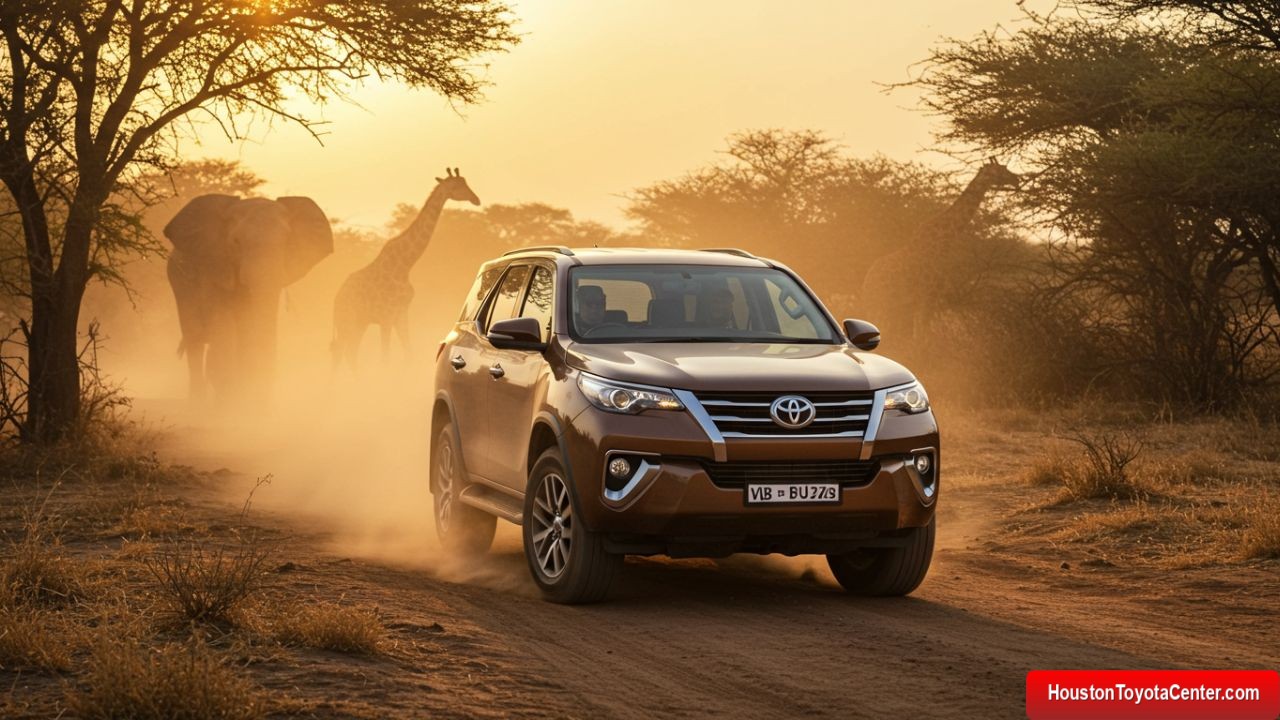When one thinks of an African safari, images of rugged landscapes, wild animals roaming free, and challenging terrains come to mind. But there’s one image that has become just as iconic — the Toyota Fortuner dominating the wilderness. In recent years, the Fortuner has established itself as the ultimate safari vehicle across the African continent. With its powerful engine, tough build, and luxurious yet practical features, it strikes the perfect balance between off-road warrior and family cruiser.
This article explores why the Toyota Fortuner is the vehicle of choice for safaris in Africa, covering everything from its off-road performance to its role in ecotourism, its popularity across African nations, real safari case studies, and maintenance tips for bush adventures.
1. The DNA of the Fortuner: Born for the Wild
The Toyota Fortuner wasn’t just made for smooth urban roads. It’s a vehicle designed from the ground up to dominate in tough conditions. Built on Toyota’s legendary Hilux platform, the Fortuner inherits the same ruggedness that’s made the Hilux one of Africa’s most trusted pickups.
Key Off-Road Features:
FREE: Quickly identify and understand problems with your vehicle 🚘
CLICK HERE| Feature | Description |
|---|---|
| High Ground Clearance | ~220 mm, allowing it to pass over rocks and uneven terrain with ease. |
| Four-Wheel Drive (4WD) | Available in low and high range, offering exceptional off-road capability. |
| Hill Assist & Downhill Control | Prevents rollback and helps control speed on steep gradients. |
| Skid Plates | Protects the underbody from rocks and branches. |
| Locking Rear Differential | Improves traction on slippery or uneven surfaces. |
These elements make the Fortuner not just capable, but confident and safe in any safari condition, from muddy marshes to desert dunes.
2. Comfort Meets Durability
Many safari vehicles sacrifice comfort for performance. The Fortuner refuses to compromise.
- Seating Capacity: Up to 7 passengers.
- Upholstery: Durable leather seats in high trims, resistant to dust and wear.
- Climate Control: Rear air conditioning ensures backseat passengers stay cool in the African heat.
- Suspension: Designed to absorb shocks from bumpy roads without causing passenger fatigue.
Whether it’s a day trip in the Serengeti or a week-long overland journey through Namibia, the Fortuner offers SUV-level comfort with 4×4 toughness.
3. Popularity Across Africa
The Fortuner has carved out a special place in the African automotive market, especially in:
| Country | Fortuner Usage Highlights |
|---|---|
| South Africa | Top-selling SUV; favored by both families and safari operators. |
| Kenya | Used in both urban settings and Maasai Mara excursions. |
| Namibia | Popular among overlanders and self-drive safari tourists. |
| Botswana | Ideal for Okavango Delta terrain and game reserves. |
| Tanzania | Often used in luxury safari fleets and national parks. |
The reliability of the Toyota brand, combined with localized dealership support and spare part availability, has helped the Fortuner thrive in both urban and remote regions.
4. Fortuner vs. Other Safari Vehicles
The African safari market features several rugged vehicles, but few compete at the Fortuner’s level of balance between comfort, affordability, and power.
| Vehicle | Off-Road Ability | Comfort | Seating Capacity | Cost-Efficiency | Winner |
|---|---|---|---|---|---|
| Toyota Land Cruiser | ★★★★★ | ★★★★☆ | 8 | ★★☆☆☆ | Luxury |
| Toyota Fortuner | ★★★★☆ | ★★★★☆ | 7 | ★★★★☆ | ✅ Best Overall |
| Nissan Patrol | ★★★★☆ | ★★★☆☆ | 7 | ★★★☆☆ | Runner-up |
| Mitsubishi Pajero | ★★★☆☆ | ★★★☆☆ | 7 | ★★★☆☆ | Budget |
| Land Rover Defender | ★★★★★ | ★★★☆☆ | 5 | ★☆☆☆☆ | Premium |
The Fortuner wins in the value-for-money category, while still offering premium features and adventure-readiness.
5. Real Safari Stories: Fortuner in Action
a. Botswana Game Reserve Explorer – “It Never Got Stuck”
Local safari guide Keitumetse shares:
“In the rainy season, we often see luxury vehicles bogged down in mud. My Fortuner never got stuck. With 4WD Low and its traction control, I could even pull out other vehicles.”
b. Namibia Overland Tour – “Tackled All Terrains”
South African tourist Julia:
“We drove across Etosha, down Skeleton Coast, and into the dunes of Sossusvlei. The Fortuner handled sand, rocks, and riverbeds without blinking.”
c. Tanzania Luxury Safari Operator – “Customer Comfort Plus Reliability”
A luxury safari company in Arusha:
“We swapped our aging Land Cruisers for Fortuners. The clients love the quiet ride and the leather interiors. Maintenance has been cut in half.”
6. Engine and Fuel Performance
Africa demands fuel efficiency with power. The Fortuner delivers both.
| Engine Option | Displacement | Power Output | Fuel Consumption (avg.) |
|---|---|---|---|
| 2.4L Diesel | 150 hp | 400 Nm | ~7.0 L/100 km |
| 2.8L Diesel | 204 hp | 500 Nm | ~7.9 L/100 km |
| 4.0L V6 Petrol (optional) | 235 hp | 376 Nm | ~10.4 L/100 km |
The 2.8L diesel is the most popular for safari use — torque-rich, durable, and more fuel-efficient in long drives through wild landscapes.
7. Tech and Safety Features for Safaris
While safaris are about unplugging from the world, some tech is crucial for safety and navigation.
- Touchscreen Infotainment with navigation (select models)
- Rear-view camera and parking sensors
- Multiple airbags including side and curtain
- Lane departure alert and pre-collision system
- Roof rails and optional snorkel for deep water crossings
- Built-in USB ports to charge phones and GPS units
These features offer modern security and convenience in the middle of nature.
8. Safari Modifications and Accessories
Want to make your Fortuner even more safari-ready? Consider these add-ons:
| Modification | Purpose |
|---|---|
| Rooftop Tent | Sleep under the stars safely off the ground. |
| Safari Snorkel | Water wading in rivers and flood zones. |
| Bull Bar | Protects front end from wildlife impacts. |
| Roof Rack + Awning | Carry gear and create shade for camps. |
| All-Terrain Tires | Better grip on sand, mud, and gravel. |
| Dual Battery System | Power fridges, lights, and accessories overnight. |
Many dealers across Africa offer these installations as packages.
9. Maintenance and Service in Remote Areas
The Fortuner’s widespread presence ensures excellent parts availability, even in small towns. Toyota’s dealer network across Africa includes:
- Regular service centers in cities
- Mobile service units in rural zones
- Local mechanics trained in Toyota repairs
- Common part stock in border regions
Always carry spare filters, tires, oil, and coolant when venturing deep into national parks.
10. Ecotourism and the Fortuner
As more safari operators embrace sustainable tourism, the Fortuner’s diesel efficiency and low CO2 emissions (compared to larger V8 models) help reduce environmental impact. It’s also less disruptive to wildlife, thanks to its quieter ride.
Additionally, Toyota has committed to improving sustainability, and hybrid Fortuner models may soon follow, especially as demand grows in Kenya, South Africa, and Ghana.
11. Fortuner Safari Tips for First-Time Drivers
- Engage 4WD before you need it. Don’t wait until you’re stuck.
- Always deflate your tires slightly for sand driving.
- Avoid driving at night in parks — wildlife is more active and visibility drops.
- Keep a GPS tracker and satellite phone in remote zones.
- Carry extra fuel — distances between stations can be long.
Conclusion: The Fortuner Legacy in Africa
Whether you’re a rugged explorer, a wildlife photographer, or a luxury safari guest, the Toyota Fortuner continues to prove itself as the ultimate safari vehicle in Africa. It offers a rare combination of affordability, strength, reliability, and luxury, all wrapped in a package that is as at home in the urban sprawl of Nairobi as it is in the heart of the Serengeti.
In the vast wilderness of Africa, the Fortuner doesn’t just survive — it thrives.


Leave a Reply